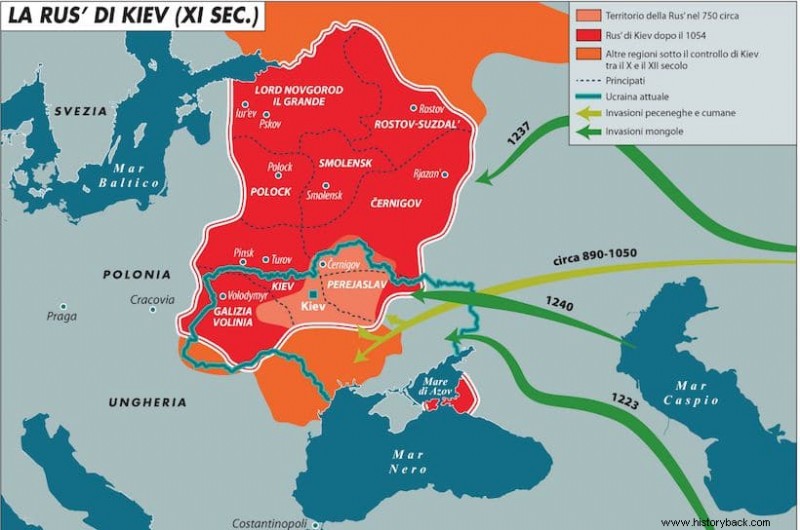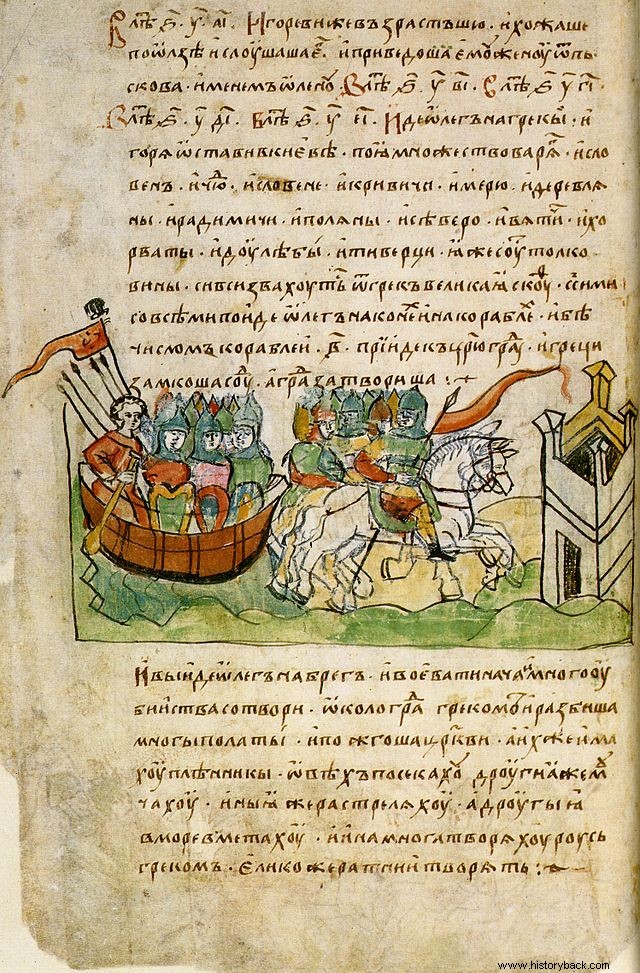When, from Scandinavia, the Vikings arrived in the lands of Slavic Europe, they established a rich monarchical entity capable of encompassing aspects that might sound familiar to us:the Kievan Rus'.
It was established in the 9th century AD, in a territory that includes today's:
Western Russia, Belarus, Ukraine, Poland, Lithuania, Latvia and Estonia.

As the name suggests, the capital of this great domain was Kiev and was chosen by a small group of Swedish Vikings, probably led by the chief Rjurik, because it represented a very important commercial center along the Variago-Greek route.
Quest ' the latter was a very important communication route that allowed northern, Slavic and Byzantine Europe to communicate and trade among themselves raw materials, slaves and the finest manufactures.

Although there are limited Slavic documents, the economic base of Kievan Rus was initially trade. Resources within the region included fur, beeswax, honey, and enslaved people, and the three trade routes taken over by Rus included critical north-south trade lines linking Scandinavia and Constantinople and east and west. from the Balkans to Greece.
Archaeologists have recovered over 1,000 birch bark tablets from the cities of Kiev, particularly Novgorod. These documents written in Old East Slavic are mainly associated with commercial endeavors:accounting, credit (documentation of debts) and tag counts (labeling).
The currency of Kievan Rus was known as the hryvnia, and in the 15th century Novgorod , 15 hryvnia constituted one ruble, equal to 170.1 grams of silver. An advanced system of commercial credit and money lending provided a line of credit open to anyone, and commercial loans were extended to both Russia and foreign traders and investors.
Each of the principalities of Kievan Rus was led by a dynastic prince. Rurik who lived in a castle in the capital. Each prince had a group of warriors (druzhina) who controlled the forts at the frontier and otherwise protected the prince's interests. Most of the elites in Druzhina were the boiars, who were owners, some of whom may have had their own castles.
Each boiar had stewards (tivun) who took care of the land, different categories of semi- free and some categories of patriarchal (domestic) and classical (property) slaves originally made up of military prisoners. Slaves were forced to work in agriculture and act as artisans and traders, but whether or not they were considered slaves is debated among scholars and apparently their status has evolved over time.
Shortly after Vladimir took the power in 980, he erected six wooden idols to the Slavic gods on his estates in Kiev. A statue of the Slavic god Perun, the god of thunder and generally associated with both Scandinavian Thor and the Iranian gods of the north, had a silver head with a golden mustache. The other statues were of Khors, Dazbog, Stribog, Simargl, and Mokosh.
Early Slavic rulers had flirted with Christianity - the Byzantine patriarch Photius first sent missionaries in 860 - but Christianity was formally established as state religion under the rule of Vladimir the Great (ruled from 980 to 1015). According to the 12th century document known as the "Chronicle of the Russian Primary," Vladimir was approached by missionaries of the Jewish, Islamic, Western Christian (Rome) and Eastern Christian (Byzantine) faiths. He sent emissaries to investigate these religions, and the envoys returned with their recommendations that Byzantium had the best churches and the most interesting services.
Modern scholars believe that Vladimir's choice of the Byzantine church was likely based on the fact that all era was at the height of its political power and the brightest cultural center in the world, with the possible exception of Baghdad.
On the death of the first regent, around 880, power passed, in theory, into the hands of the alleged son, Igor. However, in fact, the whole of Rus was ruled by Prince Oleg, known as "the Prophet". With the latter, the boundaries of the block expanded, subduing various native Slavic populations and forcing them to pay a tribute.
The first Viking attack against Constantinople took place under the prince's regency. There are no mathematical certainties as to who got the better of the clash, but it led, in 911, to both the first commercial relationship ever existed between a Norse population and the Byzantine Empire and a military agreement, which provided for the participation of Rus' in all the military campaigns carried out by the very rich capital of the Eastern Roman Empire.
The strength shown outside, however, did not coincide with the internal one. The position of regent of the principality was very unstable and in a very short time a series of characters followed one another who always carried out two common elements in their politics:the clash against Byzantium (and the consequent reconciliation with short treaties) and the oppression of the populations. native Slavs who rebelled.
This last element is important, because not all tribes had hostile attitudes against the new principles. Many were willing to swear solemn allegiance to Kiev by marrying the Viking rulers with their indigenous daughters. It will be from this union between Norsemen and Slavs that modern Russians will be born.
The political, economic and cultural peak of Rus' came with the regency of Vladimir the Great. With him, the principality became a united entity - capable of resisting even the threats from the Asian steppes. At this stage, power was definitively consolidated, uniting the former native populations from today's Ukraine to the entire Baltic Sea.
Vladimir was a very far-sighted guide and, although he once tried to penetrate the Byzantine city - failing, he often made deals with enemies. For example, in 988, twenty years before the fateful 11th century, 6000 men were sent to Basil II, the then emperor of Constantinople, to form a very famous and ruthless mercenary brigade:the Guardia Variaga.
The main reason of the end of Kievan Rus' was the political instability created by the succession rules. All the various principalities were ruled by members of the Rurik dynasty, but it was a succession of scales. The members of the dynasty were assigned territories, and the main one was Kiev:each territory was headed by a prince (tsar), but in Kiev the Grand Prince led them all. When the Grand Prince died, the next legitimate heir, the oldest heir of the Rurik dynasty, not necessarily a son, left his principality and moved to Kiev.
After Vladimir's death in 1015, there were three years of disorder during which two of his sons (Boris and Gleb) were killed at the request of another son, Sviatopolk. The two would become the first saints of the Slavic church. In 1018, Yaroslav the Wise, one of the surviving sons, ascended the throne and held it until 1054.
Although under Yaroslav's rule, Kievan Rus' continued to expand and a variety of marriages with royal families in Europe - Poland, Norway, England - continued to maintain the trade power of the federation. But when Yaroslav died in 1054, power passed to his son Izaiaslav, who became enthralled in a succession battle that lasted through several rulers until 1240, when the Mongols attacked Kiev. The northern part remained under the control of the Golden Horde; the rest became fragmented.
